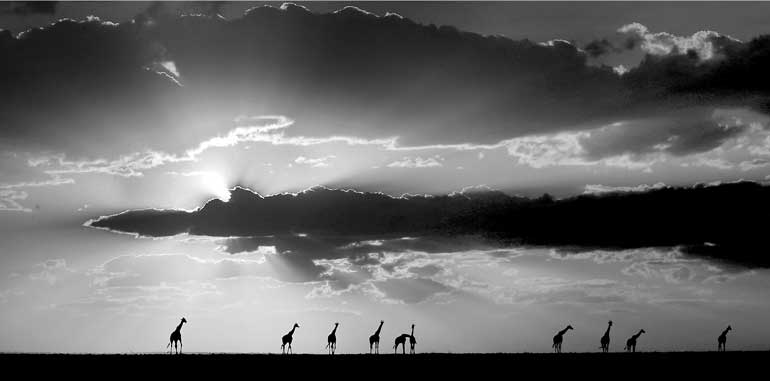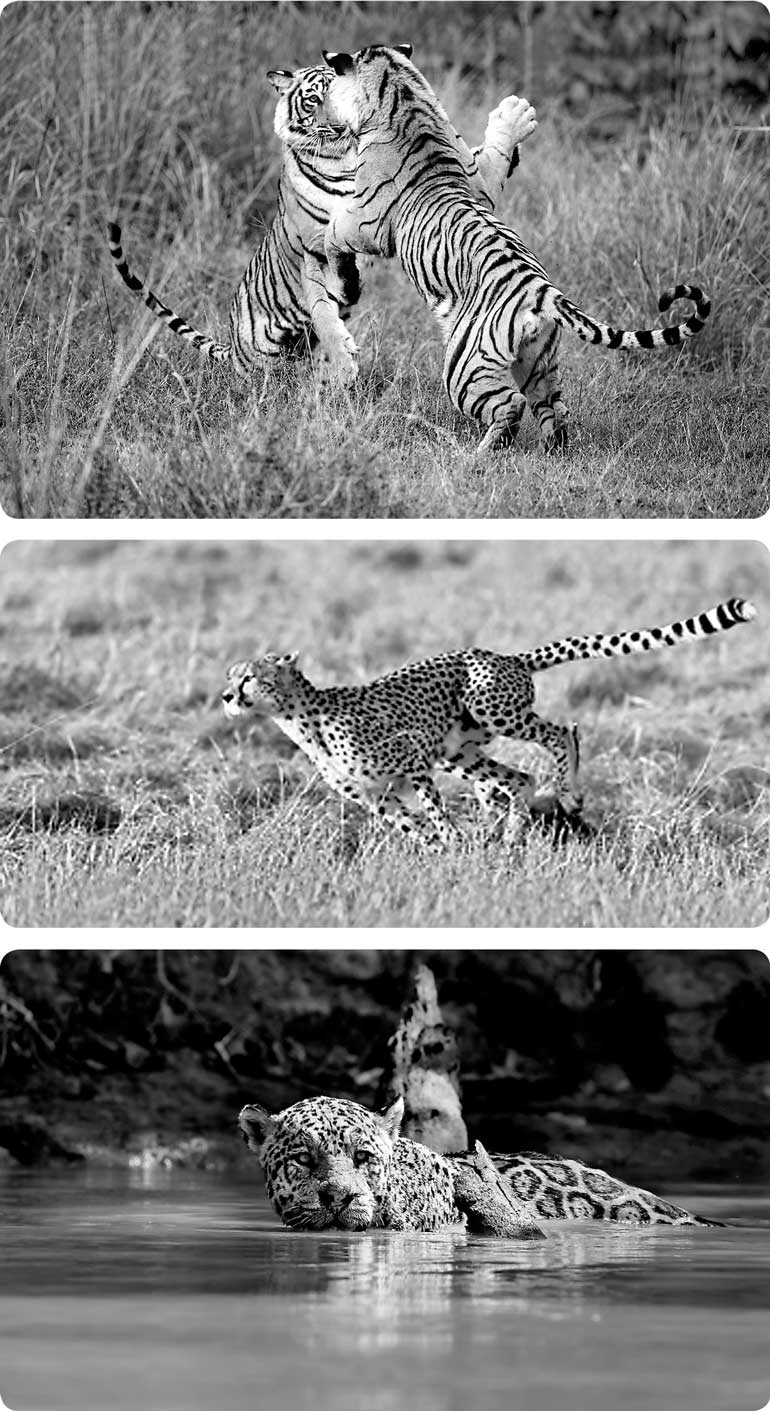Friday Mar 21, 2025
Friday Mar 21, 2025
Saturday, 28 October 2017 00:00 - - {{hitsCtrl.values.hits}}

 By Chitral Jayatilake
By Chitral Jayatilake
Living in an island that is as photogenic as Sri Lanka, it was natural that we were inspired to launch guided photographic safaris in search of all that is wild and free in this resplendent land.
After two decades of intense passion discovering and documenting the wilderness of the country, it was time to explore what’s wild and free beyond the shores. This led to the natural decision of exploring the great Indian wilderness, the land of the tiger.
We set out on our recce to Ranthambhore, then Bandhavgarh and Tadoba national parks, and for the sheer ease of sighting the majestic tiger, we settled to operate photographic safaris in the magical Rajasthan wilderness of Ranthambhore. The mighty tigers make the other cats seem mere dwarfs, except of course the male lions adorned with their stunning manes that almost match the grace and power displayed by the tiger in the Indian forests.
Seven guided tiger safaris left us overwhelmed and mesmerised, cumulating over 60 tiger sightings, sloth bears, leopards and more of the exotic creatures the Indian forests had to offer. Going in search of comb ducks and Indian skimmers along with the impressive gharials in Madhya Pradesh along the Chambal River was another fulfilling encounter.
The successful run in India led to the inevitable progression to explore Africa. Our work began in the Mara-based in Kenya, covering the greatest wilderness of all, and then we moved on to the many private conservancies which enhanced the experience of game viewing almost parallel to Botswana. A visit to Africa is guaranteed to change the mindsets of many. One will find themselves struggling to grasp the vast wilderness dotted with endless herbivores and much of the planets, great predators, depicting the game of life and death on the basest level, every day, in the African plains.
Africa has its magical ways of carving unimaginable impressions on its visitors. The bonds of large predators that moves in packs, the brute strength of the males that jealously guard their possessions and the crafty leopards that slink away from stronger predators, and menacing hyenas in their efforts to be unseen, is an unending drama enacted daily on the great plains.
We were simply captivated by a cheetah chasing a reed buck, as it streamed through the open savannah for its life, just to be beaten by the sheer speed and incredible balance of the fastest animal on earth. On the African plains, often, the most enthralling moments are also the greatest heartbreakers that showcase the struggles of each animal and the survival of the fittest each day that contributes to the circle of life and in turn sustenance of its progeny.
The next adventure led us to the land of the mountain gorilla. Once a devastated nation torn by civil unrest in 1994, Rwanda today is an exemplary model of effective reconciliation. It’s amazing that a single iconic species has the power to transform this nations’ perception of being a land of genocide to the land of the gorillas; yet another classic example of effective nation branding through effective conservation.
The sheer discipline of this operation implemented with almost military precision to show the gorillas to the guests is highly commendable, and definitely a model for Sri Lanka to follow in terms of controlling unprecedented crowds and jeeps within precious national parks situated in our own wilderness.
I was then transported to a different spectrum in a European nation on the invitation of a former ‘BBC Photographer of the Year’, Bence Mate, whose highly-commended entries to this coveted competition exceed any single person’s achievements.
This was a unique photographic expedition in search of hide photography. The landscapes and settings almost resembled forest birds in a bird studio. Bence is a unique talent and his 50-acre private estate in Hungary, houses over 20 hides. Simple accommodation for fanatical birders to capture behaviour hitherto unseen, whilst based in semi-comfortable to luxury hides, offering heated accommodation, Wi-Fi, snacks and a bunk bed if one needs a snooze while their colleagues wait for action to unfold.
The hides offer classic opportunities to capture the nesting, mating and feeding behaviour of many birds, raptors, owls and even the European otter. The simple and advanced techniques used to help photographers, ensure breathtaking images that are both creative and effective with the promise of guests leaving Bence’s farm rich with images that capture the thought process behind each photograph. The experience, also tests the visiting photographers patience to its extreme.
Amboseli was another unique adventure in search of some of Africa’s largest tuskers with its stunning open terrains on which the herds move silently and only a puff of dust indicates the arrival of another herd on the horizon. Herds with over fifty elephants, all harbouring precious ivory amidst the desert-like back-drop, makes for unique and rare photographic opportunities that ardent enthusiasts dream of. My friends at Kicheche Tented Lodge and Tortillis Camps made their best guides available for our game drives. These guides were experts with the ability to read the terrain and tracks just like a map, and could predict animal behaviour just by looking at trail marks.
With multiple threats placing enormous pressure on the earth’s resources, especially the natural world, it’s almost a miracle that we still have so much wilderness intact. It seems like one lifetime isn’t adequate to explore much of this world that still lives free, defying the odds of human greed and inaction to preserve what’s wild and irreplaceable.
I consider myself truly blessed to be bestowed the opportunity to witness so much, and in turn share such fleeting moments with a great bunch of friends, with whom we have created unforgettable memories whilst travelling in the vast African plains and beyond, yet only exploring a minute fraction of what is still wild and free on this blue planet.
(This article first appeared in ‘Living Free’, a 196-page book of wildlife photographs by two of the country’s best-known shutterbugs Chitral Jayatilake and Vimukthi Weeratunga.)
Discover Kapruka, the leading online shopping platform in Sri Lanka, where you can conveniently send Gifts and Flowers to your loved ones for any event including Valentine ’s Day. Explore a wide range of popular Shopping Categories on Kapruka, including Toys, Groceries, Electronics, Birthday Cakes, Fruits, Chocolates, Flower Bouquets, Clothing, Watches, Lingerie, Gift Sets and Jewellery. Also if you’re interested in selling with Kapruka, Partner Central by Kapruka is the best solution to start with. Moreover, through Kapruka Global Shop, you can also enjoy the convenience of purchasing products from renowned platforms like Amazon and eBay and have them delivered to Sri Lanka.
Discover Kapruka, the leading online shopping platform in Sri Lanka, where you can conveniently send Gifts and Flowers to your loved ones for any event including Valentine ’s Day. Explore a wide range of popular Shopping Categories on Kapruka, including Toys, Groceries, Electronics, Birthday Cakes, Fruits, Chocolates, Flower Bouquets, Clothing, Watches, Lingerie, Gift Sets and Jewellery. Also if you’re interested in selling with Kapruka, Partner Central by Kapruka is the best solution to start with. Moreover, through Kapruka Global Shop, you can also enjoy the convenience of purchasing products from renowned platforms like Amazon and eBay and have them delivered to Sri Lanka.